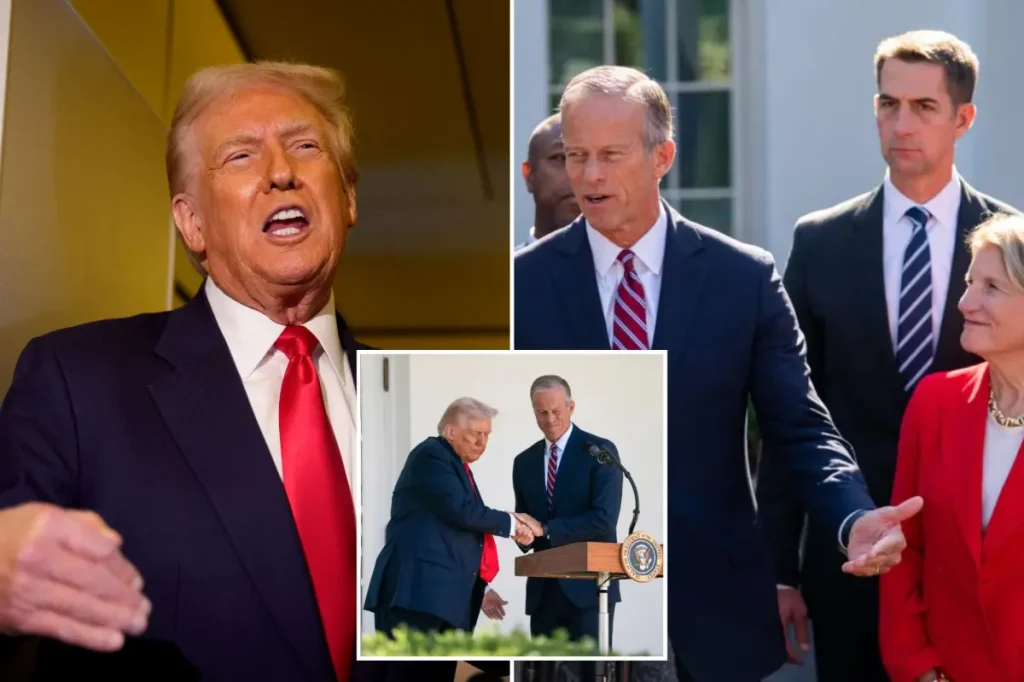Trump Calls for Nuclear Option to End Government Shutdown
In a bold move amidst the ongoing government shutdown crisis, President Trump has urged Republicans to invoke the “nuclear option” – eliminating the Senate filibuster to allow legislation to pass with a simple majority rather than the current 60-vote requirement. Through a passionate message on Truth Social, Trump expressed frustration over the 30-day shutdown that has paralyzed federal operations. “It is now time for the Republicans to play their ‘TRUMP CARD,'” he declared, calling for immediate action to break the legislative deadlock that has prevented the passage of a continuing resolution to fund the government. This dramatic appeal comes after Trump’s recent whirlwind trip to Asia, where he faced repeated questions about how Democrats could “SHUT DOWN the United States of America” and why Republicans weren’t doing more to prevent it – questions that he says prompted deep reflection during his long flight back from South Korea.
The current political impasse stems from what Trump characterizes as partisan obstruction, despite what he views as strong leadership from Senate Majority Leader John Thune and House Speaker Mike Johnson. Trump didn’t mince words in describing the opposition, calling Democrats “Crazed Lunatics that have lost all sense of WISDOM and REALITY” and suggesting their behavior represents “a sick form of the now ‘legendary’ Trump Derangement Syndrome.” The practical reality is that Senate Republicans find themselves in a frustrating position – they need 60 votes to advance a temporary funding bill to reopen the government at previous spending levels, but all except three Senate Democrats have consistently voted against the Trump-backed proposal since funding lapsed on October 1st. This has created a seemingly insurmountable hurdle, with Republicans needing five more votes they simply cannot secure under current Senate rules.
Trump points out the irony in the situation, noting that Democrats previously fought for three years to eliminate the filibuster when they held power but were prevented from doing so by moderate Democrats Joe Manchin and Kyrsten Sinema. “Never have the Democrats fought so hard to do something because they knew the tremendous strength that terminating the Filibuster would give them,” Trump wrote, arguing that Democrats would have used a simple majority to pursue an agenda including expanding the Supreme Court and granting statehood to Washington, D.C. and Puerto Rico – moves he claims would automatically give Democrats “4 Senate seats, many House seats, and at least 8 Electoral Votes.” The president’s argument essentially turns the Democrats’ previous strategy against them: what was once their desired procedural change should now be employed by Republicans to end what Trump calls a “ridiculous, Country destroying ‘SHUT DOWN.'”
Beyond just reopening the government, Trump envisions broader benefits from eliminating the filibuster. He suggests Republicans could secure “the best Judges, the best US Attorneys, the best of everything” without needing to reach the 60-vote threshold. Trump frames this approach as poetic justice, describing it as “a concept from years ago of then President Barack Hussein Obama and former Majority Leader Harry Reid in order to take advantage of the Republicans. Now I want to do it in order to take advantage of the Democrats…” His messaging carries a sense of urgency and political opportunity, portraying the nuclear option as both a necessary response to Democratic obstruction and a chance for Republicans to advance their agenda more broadly during their time in power.
Trump’s call for the nuclear option represents a significant escalation in the shutdown strategy, emphasizing his belief that extraordinary measures are justified by what he sees as Democratic extremism. In a separate post, he reinforced his position with characteristic all-caps emphasis: “BECAUSE OF THE FACT THAT THE DEMOCRATS HAVE GONE STONE COLD ‘CRAZY,’ THE CHOICE IS CLEAR — INITIATE THE ‘NUCLEAR OPTION,’ GET RID OF THE FILIBUSTER AND, MAKE AMERICA GREAT AGAIN!” This rhetoric frames the procedural change not merely as a tactical response to the current crisis but as an essential part of Trump’s broader political vision. It presents Republicans with a stark choice between preserving Senate traditions and pursuing immediate policy wins, with Trump clearly advocating for the latter.
Despite Trump’s forceful advocacy, significant obstacles remain to implementing the nuclear option. Senate Majority Leader John Thune had previously pledged to preserve the filibuster when Republicans took control of the Senate in January, recognizing its long-term institutional importance beyond short-term political gains. Earlier this month, Thune dismissed the idea of using the nuclear option to end the shutdown and indicated he hasn’t discussed it with the White House – suggesting a potential disconnect between the president’s public messaging and Senate leadership’s strategic thinking. This reluctance highlights the complex calculations facing Republican leaders: while eliminating the filibuster might solve the immediate shutdown crisis, it would fundamentally alter Senate procedures in ways that could disadvantage Republicans when they eventually return to minority status. As the shutdown continues with no end in sight, this tension between short-term problem-solving and long-term institutional preservation remains at the heart of the Republican response.


